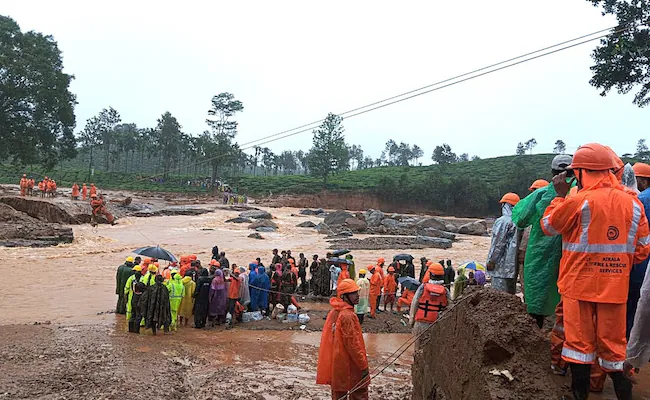- Homepage
- LATEST NEWS
- 143 Dead In Wayanad Landslides, Several Still Trapped Amid Heavy Rain Alert
143 Dead In Wayanad Landslides, Several Still Trapped Amid Heavy Rain Alert
Wayanad, a picturesque district in Kerala, has been ravaged by a devastating landslide that has claimed the lives of 143 people and left many more trapped under the rubble. This tragic event has prompted a heavy rain alert, further complicating rescue and relief efforts.
Table of Contents
ToggleBackground on Wayanad
Nestled in the Western Ghats, Wayanad is known for its lush landscapes and heavy monsoons. The region’s unique geography makes it prone to landslides, especially during the rainy season. Over the years, Wayanad has faced several natural disasters, but the current situation is among the worst in its history.
Details of the Landslide
The landslide struck late at night, catching many residents off guard. Entire villages have been buried, with the worst-affected areas being Puthumala and Meppadi. The landslide’s immediate impact was catastrophic, with homes, roads, and farms completely destroyed.
Casualties and Rescue Operations
As of now, 143 deaths have been confirmed, and rescue teams are racing against time to save those still trapped. The challenging terrain and continuous rainfall are hampering efforts, making it a daunting task for rescuers. The National Disaster Response Force (NDRF), local authorities, and volunteers are working tirelessly to reach the affected areas.
Government Response
In response to the disaster, the Kerala government has deployed additional resources to aid in the rescue operations. Chief Minister Pinarayi Vijayan has assured that all necessary measures are being taken to assist the victims. The government has also announced financial aid for the affected families and is coordinating with various agencies to expedite relief efforts.
Role of Weather Conditions
The landslide was triggered by incessant rainfall, which has been relentless over the past few weeks. The heavy rain alert remains in effect, with meteorologists predicting more downpours in the coming days. This has raised concerns about further landslides and the safety of both the residents and rescue workers.
Community Impact
The landslide has left a profound impact on the local community. Many families have lost loved ones, their homes, and their livelihoods. Temporary shelters have been set up to accommodate the displaced, but the emotional and psychological toll is immense. Stories of survival and loss are emerging, painting a grim picture of the tragedy.
Infrastructure Damage
The destruction of infrastructure is extensive. Roads have been washed away, making certain areas inaccessible. Buildings have collapsed, and essential services like water and electricity are disrupted. Rebuilding will require significant time and resources, posing a major challenge for the local administration.
Environmental Consequences
The landslide has also caused considerable environmental damage. Large swathes of forest cover have been lost, affecting the local wildlife. Soil erosion is a major concern, and the risk of water contamination looms large as debris has blocked several water bodies.
Role of NGOs and Volunteers
Non-governmental organizations (NGOs) and volunteers have stepped up to provide much-needed support. They are involved in rescue operations, distributing relief materials, and offering medical aid. Their efforts are crucial in reaching remote areas and ensuring that help is available to all those in need.
Health and Safety Concerns
The immediate health risks include injuries from the landslide and potential outbreaks of waterborne diseases due to contaminated water sources. Authorities are focusing on providing clean drinking water, sanitation facilities, and medical care to prevent any health crisis.
Economic Impact
The economic repercussions of the landslide are severe. Many farmers have lost their crops, and small businesses are struggling to cope with the damages. The estimated cost of rebuilding and recovery is substantial, and support from the government and international community will be vital.
Long-Term Recovery Plans
Rebuilding Wayanad will be a long and arduous process. The government, along with NGOs, is formulating comprehensive recovery plans. These include reconstructing homes, restoring infrastructure, and implementing measures to mitigate the impact of future natural disasters. Community involvement will be key to these efforts, ensuring that the affected residents have a say in how their villages are rebuilt.
Expert Opinions
Geologists and meteorologists have been analyzing the landslide to understand its causes and prevent future occurrences. They emphasize the need for better land management practices and improved early warning systems. Disaster management experts recommend building resilient infrastructure and creating awareness among the local population about the risks and precautions.
Conclusion
The Wayanad landslide is a stark reminder of nature’s unpredictable fury. The loss of lives and property is heart-wrenching, but the resilience and solidarity of the affected community offer a glimmer of hope. As rescue and relief operations continue, it is crucial for everyone to support the efforts in any way possible. Preparing for future disasters and ensuring the safety and well-being of vulnerable regions must be a priority.
FAQs
1. What caused the Wayanad landslide? The landslide was triggered by heavy rainfall that caused soil erosion and destabilized the terrain, leading to the collapse.
2. How many people have been affected? The landslide has claimed 143 lives, with many more injured or displaced. Rescue operations are ongoing to save those still trapped.
3. What is being done to help the survivors? Rescue teams, NGOs, and the government are working together to provide relief materials, medical aid, and temporary shelters for the survivors.
4. How can future landslides be prevented? Preventing future landslides requires better land management, reforestation, and improved early warning systems to alert residents in vulnerable areas.
5. What can individuals do to support the relief efforts? Individuals can donate to reputable NGOs, volunteer in relief efforts if possible, and raise awareness about the situation to garner more support.







